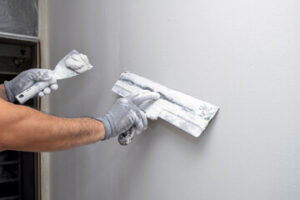Stucco Finishing
Consider a stucco finish to give your building a new look. This type of finish consists of a fairly smooth base coat and then a texture coat. The texture is sprayed on, knocked down, or skipped across with a wet trowel. There are many different styles and textures to choose from.
 Stucco is a popular siding material that is used on many homes across the country. It can be a smooth or textured finish, depending on its application. A smooth stucco finish is growing in popularity for new construction and renovations. It’s a great way to keep your home looking its best.
Stucco is a popular siding material that is used on many homes across the country. It can be a smooth or textured finish, depending on its application. A smooth stucco finish is growing in popularity for new construction and renovations. It’s a great way to keep your home looking its best.
It’s also easy to power-wash and paint to update its look so if you have a dingy, rough texture that you don’t like or simply want to change the style of your house, consider hiring a professional to resurface your stucco.
The most common type of textured stucco is a sand finish. It’s a popular choice for production home builders because it’s easy to apply and hides imperfections well. However, it is not as forgiving to repair if there are cracks.
Stucco is a type of exterior wall siding applied over a stable base, called lath. It can be made of cement, lime, water, or synthetic resins and may also include glass fibers for extra durability.
It can be three-coat or four-coat in construction and includes a scratch coat that creates adhesion to the lath, a brown coat, and a finish coating. The finish is typically a textured or smooth coat.
True to its name, this texture looks like the worms of a pond have invaded the stucco and left little pathways in it. Trowels are used to push a few pieces of aggregate around the surface, leaving the indentations that make this look so characteristic.
Plaster bagworms, or household casebearers, are common in high-humidity areas like Florida. They feed on spiderwebs, hair, and other organic materials in and around homes. Keeping your home clean, removing old webs and vacuuming regularly will help keep these pests away.
Stucco Finishing is an amazing way to create a unique and custom home. It can be swirled, raked, smoothed, pebbled, laced, combed, webbed or cat-faced in various ways to give a beautiful texture to your exterior walls.
Dash or roughcast stucco finishes are popular for those who want a heavily textured look. This type of stucco has grooves in it, which are caused by larger pieces of aggregate in the mixture that leave a rough appearance to the wall.
This stucco style can be used on homes with many exterior sections and is also good for businesses that need a textured surface. It’s easy to patch up and comes in a wide range of textures.
This type of stucco is a bit more difficult to apply than other texture types, but it can give you a beautiful and unique look. It’s also durable and low maintenance, so it’s worth the effort.
Sand is one of the most important materials in stucco. It is used to create the structure of the stucco mix and it also provides texture to the finish.
The sand should be clean, sharp and angular (not worn or rounded). A good plaster sand should have a diversity of particle sizes.
Rough stucco has been in use for many years, but it is being replaced by smooth finish stucco as it is a lot more attractive and less expensive to maintain. To get a smooth stucco surface, it is important to sand down the rough surface using high grit sandpaper.
This method is a quick and effective way to apply sand finish stucco to the wall. The sand is mixed with the base coat and then applied to the wall by troweling. It can be done by hand or with a machine. It requires a bit of time to dry up and is best used on walls not exposed to harsh weather conditions.
Stucco finishing is a type of exterior wall finish made by applying a mixture of cement, sand, and water to the surface of a building. Stucco finishing is often used in construction projects to give buildings an attractive, long-lasting exterior finish. Stucco is a popular choice for its durability, low maintenance, and versatility in texture and color. Stucco finishing can be done in various ways, such as using a trowel or a sprayer, and can be finished in different textures, from smooth to rough. It is important to properly prepare the surface before applying the stucco, including cleaning, repairing any cracks or damage, and adding a layer of mesh or wire for added strength.
